(单词翻译:单击)
中英文本
Subsequent economists have tried to make sense of Say's law in the following way.
后来的经济学家试图用下面这种方式理解萨伊定律。
Imagine an economy that consists only of shoes and hats.
假设一个经济体,它仅由鞋子和帽子组成。
The cobblers intend to sell $100-worth of shoes in order to buy the equivalent amount of hats.
鞋匠想销售价值100美元的鞋,以便购买总价等量的帽子。
The hatters intend to sell wares worth $80 so as to spend the same sum at the cobbler's.
帽匠想卖出价值80美元的货物,以便在鞋匠那里花出等量的钱。
Each plan is internally consistent (planned spending matches revenue).
每一项计划都是内在一致的(计划支出与收入相匹配)。

Added together, they imply $180 of sales and an equal amount of purchases.
加在一起,它们意味着价值180美元的销售和等量总价的购买。
Sadly, the two plans are mutually inconsistent.
不幸的是,这两项计划是相互不一致的。
In the shoe market the producers plan to sell more than the consumers will buy.
在鞋市场中,生产方计划比消费者想要购买的多销售一些。
In the hat market the opposite is the case.
帽子市场的情况正好相反。
A journalist, attentive to the woes of the shoe industry, might bemoan the economy's egregious overcapacity and look askance at its $180 GDP target.
关注制鞋行业痛苦的记者可能会对经济体的严重产能过剩表示悲哀,并以怀疑的目光看待其180美元的GDP目标。
Cobblers, he would conclude, must grasp the nettle and cut production to $80.
他会总结道,鞋匠必须大胆地解决问题,将产量降至80美元。
The journalist might not notice that the hat market is also out of whack, in an equal and opposite way.
记者可能没有注意到,帽子市场也乱了套了,以总价相等、方向相反的方式。
Hat-buyers plan to purchase $100 from producers who plan to sell only $80.
买帽子的人计划从准备只销售价值80美元货物的生产方那里购买价值100美元的帽子。
Unfortunately, this excess demand for hats cannot easily express itself.
不幸的是,对帽子的这部分超额需求不能容易地表达自己。
If cobblers can only sell $80 of shoes, they will only be able to buy the equivalent amount of hats.
如果鞋匠只能卖出价值80美元的鞋,他们将只能够购买总价相等的帽子。
No one will see how many hats they would have bought had their more ambitious sales plans been fulfilled.
没有人会搞明白,他们在自己更加野心勃波的计划得以实现的条件下会买多少帽子。
The economy will settle at a GDP of $160, $20 below its potential.
经济体将定格在160美元的GDP,比潜力低了20美元。
Say believed a happier outcome was possible.
萨伊相信,一种更乐观的结果是可能的。
In a free market, he thought, shoe prices would quickly fall and hat prices rise.
他认为,在自由市场中,鞋价会快速下跌,帽价会快速上升。
This would encourage shoe consumption and hat production, even as it discouraged the consumption of hats and production of shoes.
这会鼓励鞋的消费和帽子的生产,纵然这打击了帽子的消费和鞋的生产。
As a result, both cobblers and hatters might sell $90 of their good, allowing the economy to reach its $180 potential.
结果,帽匠和鞋匠可能会双双售出价值90美元的产品,使经济体达到180美元的潜力。
In short: what the economy required was a change in the mix of GDP, not a reduction in its level.
简言之:经济体所需要的是GDP组合的变化,而不是GDP水平的缩减。
Or as one intellectual ally put it, “production is not excessive, but merely ill-assorted”.
正如萨伊的一位学界盟友所言:“生产不是过剩,而是协调得不好而已”。
Supply gives people the ability to buy the economy's output.
供给赋予人们购买经济体产出的能力。
But what ensures their willingness to do so?
但是,是什么保证了他们做这种事的意愿呢?
According to the logic of Say and his allies, people would not bother to produce anything unless they intended to do something with the proceeds.
根据萨伊及其盟友的逻辑,除非想干点有盈利的事情,否则人们是不会费心去生产任何东西的。
Why suffer the inconvenience of providing $100-worth of labour, unless something of equal value was sought in return?
除非具有同等价值的东西是作为回报所追求的,不然,为什么要承担提供价值100美元的劳动力的不方便呢?
Even if people chose to save not consume the proceeds, Say was sure this saving would translate faithfully into investment in new capital, like his own cotton factory.
即便人们选择储蓄而不是消费这些盈利,萨伊还是确信,这些储蓄会如实地转变为新资本中的投资,就像他自己的棉纺厂一样。
And that kind of investment, Say knew all too well, was a voracious source of demand for men and materials.
而且,萨伊也很了解,这种投资是对人力和原材料需求的一个贪婪之源。
译文来源考研英语时事阅读
重点讲解
1.make sense of 弄清楚
例句:Provided you didn't try to make sense of it, it sounded beautiful
只要不非得弄懂它的意思,它听上去还是很美的。
2.in return 作为回报
例句:I'll sell at a discount in return for a speedy sale.
为了尽快售出,我会打折销售。
3.In short 简而言之
例句:I have neither the time nor the inclination; in short, I refuse to do it.
我是既没工夫又没兴趣,总之,我不干。
4.As a result 结果
例句:As a result, industry was overmanned and pen-pushers were everywhere.
结果是,企业人浮于事,到处都是耍笔杆子的人。


